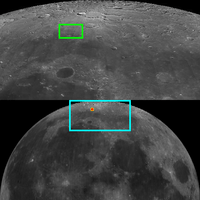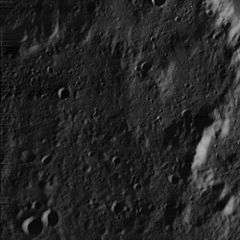Birmingham (crater)
Birmingham is the surviving remnant of a lunar impact crater. It is named after the astronomer John Birmingham (not, as is often stated, the British city nor its Alabama namesake). The crater is located near the northern limb of the Moon, and so is viewed from the Earth at a low angle.
 Location of the lunar crater Birmingham. | |
| Coordinates | 65.1°N 10.5°W |
|---|---|
| Diameter | 92 km |
| Depth | 1.8 km |
| Colongitude | 13° at sunrise |
| Eponym | John Birmingham |

All that survives of the original formation is an irregular perimeter of low, indented ridges surrounding the lava-resurfaced interior. The inner floor is marked by several tiny craterlets, and the surface is unusually rough for a walled plain. The low angle of illumination allows fine details of this boulder-strewn field to be seen more clearly.
Location
The Birmingham formation lies just to the north of the Mare Frigoris, and to the east of the walled plain W. Bond. To the northeast is the smaller crater Epigenes, with Fontenelle to the west.
Satellite craters
By convention these features are identified on lunar maps by placing the letter on the side of the crater midpoint that is closest to Birmingham.
| Birmingham | Latitude | Longitude | Diameter | |
|---|---|---|---|---|
| km | mi | |||
| B | 63.6° N | 11.3° W | 8 | 5.0 |
| G | 64.5° N | 10.2° W | 5 | 3.1 |
| H | 64.4° N | 10.6° W | 7 | 4.3 |
| K | 65.0° N | 13.1° W | 6 | 3.7 |
References
- Andersson, L. E.; Whitaker, E. A. (1982). NASA Catalogue of Lunar Nomenclature. NASA RP-1097.CS1 maint: ref=harv (link)
- Blue, Jennifer (July 25, 2007). "Gazetteer of Planetary Nomenclature". USGS. Retrieved 2007-08-05.CS1 maint: ref=harv (link)
- Bussey, B.; Spudis, P. (2004). The Clementine Atlas of the Moon. New York: Cambridge University Press. ISBN 978-0-521-81528-4.CS1 maint: ref=harv (link)
- Cocks, Elijah E.; Cocks, Josiah C. (1995). Who's Who on the Moon: A Biographical Dictionary of Lunar Nomenclature. Tudor Publishers. ISBN 978-0-936389-27-1.CS1 maint: ref=harv (link)
- McDowell, Jonathan (July 15, 2007). "Lunar Nomenclature". Jonathan's Space Report. Retrieved 2007-10-24.CS1 maint: ref=harv (link)
- Menzel, D. H.; Minnaert, M.; Levin, B.; Dollfus, A.; Bell, B. (1971). "Report on Lunar Nomenclature by the Working Group of Commission 17 of the IAU". Space Science Reviews. 12 (2): 136–186. Bibcode:1971SSRv...12..136M. doi:10.1007/BF00171763.CS1 maint: ref=harv (link)
- Moore, Patrick (2001). On the Moon. Sterling Publishing Co. ISBN 978-0-304-35469-6.CS1 maint: ref=harv (link)
- Price, Fred W. (1988). The Moon Observer's Handbook. Cambridge University Press. ISBN 978-0-521-33500-3.CS1 maint: ref=harv (link)
- Rükl, Antonín (1990). Atlas of the Moon. Kalmbach Books. ISBN 978-0-913135-17-4.CS1 maint: ref=harv (link)
- Webb, Rev. T. W. (1962). Celestial Objects for Common Telescopes (6th revised ed.). Dover. ISBN 978-0-486-20917-3.CS1 maint: ref=harv (link)
- Whitaker, Ewen A. (1999). Mapping and Naming the Moon. Cambridge University Press. ISBN 978-0-521-62248-6.CS1 maint: ref=harv (link)
- Wlasuk, Peter T. (2000). Observing the Moon. Springer. ISBN 978-1-85233-193-1.CS1 maint: ref=harv (link)
| Wikimedia Commons has media related to Image:Lunar_crater_Birmingham.png. |
